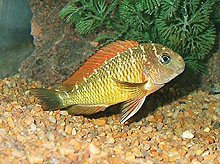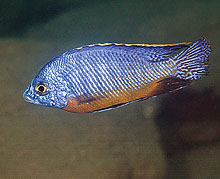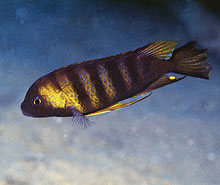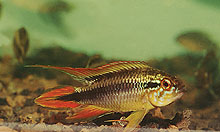WHAT'S NEW ACROSS THE WORLD
| What's New ©by
Laif DeMason
It has been very cold in many parts of the United
States this winter – very cold! There’s little doubt that unfavorable shipping
conditions and increased security threats to airlines at the turn of the
New Year have led to delays and shortages to some degree in tropical fish
supplies. Some collectors and exporters around Lake Tanganyika have thrown
in the towel, leaving a more reasonable number of suppliers. Cichlid interest
and sales have maintained a higher level compared to the recent past. Less
oversupply for the current demand seems to help this trend. New cichlid
hobbyists are often willing to “shell out” for infrequently seen items.
Prices for cichlids are still at a historic bargain compared to the decades
before!
Here’s “what’s new” on the cichlid scene: |
Lake Tanganyika
The big news is that some collectors/exporters in both Tanzania and
Zambia have closed down their activities for good. This development has
been welcomed by the remaining collectors, as they foresee an end to oversupplies
and price-slashing. The actual “shake down” effects remain to be seen.
Supplies from Burundi are good and timely, while activities in Zambia and
Tanzania are slower to start in 2004. Infrequent and rumored collections
are still reported from Congo.
|
what's new: Lake Tanganyika
|

Collected infrequently near the border of Zambia and
Congo, Julidochromis dickfeldi “Moliro” is available again. |

Collected occasionally near Nkamba (Zambia) in areas
infested with large crocodiles, Tropheus moorii “Ilangi” is exported
from time to time. |

Also from Zambia but collected near the Nangu River
is a yellow rainbow variety, known as Tropheus moorii “Linangu.” |

Collected near Kapampa (Congo) and exported from Zambia,
Neolamprologus marunguensis (a N. brichardi-type) has been shipped
again. Photo by A. Konings. |
Lake Malawi
Supplies from all corners of Lake Malawi seem to be good. Several novel
varieties are available from time to time from the Malawi coast, which
is most welcome. Small mbuna types seem to be more popular than ever, with
colorful Aulonocara or peacock types also in demand. Bred supplies are
holding up although spotty shortages from Florida have been reported.

A new variety of Metriaclima aurora is collected
from Cobwé, Mozambique. |

A seasonal predator, Dimidiochromis dimidiatus
is only rarely exported. Photo by A. Konings. |

Available from farms many years ago and long forgotten,
Metriaclima sp. “patricki” has been collected near Jalo Reef recently. |

Another novel H. steveni-type, Protomelas taeniolatus
“Chilumba Jetty” was exported for the first time last year. Photo by A.
Konings. |

Only seasonally available from northern Tanzania,
Sciaenochromis ahli —sometimes called “big-eye ahli” — is the correct
fish for this name, not H. “electric blue”! |

Shipped to Florida by Eric Fleet over 20 years ago,
the so-called “green zebra” is actually Cynotilapia sp. “Mbweca”,
an afra-type from Mozambique! Photo by A. Konings. |
West Africa
Exporters in Guinea and Cameroon are “chomping at the bit” to jump in
on the new popularity of cichlid species from there. They are ready to
supply any demand. Long delays in the usual rains in Congo have reportedly
resulted in short supplies of riverine species near Kinshasa. Nigerian
suppliers are shipping per normal.

One of the more interesting cichlids from Cameroon
is Pelvicachromis taeniatus “Bipindi”; a male is pictured here.
Photo by O. Lucanus. |

From Mungo (Cameroon), Benitochro- mis (Chromidotilapia)
finleyi “mungo blue” is one of the more colorful members of this group.
Photo by O. Lucanus. |
Neotropics
Exports of material from South American countries are running smoothly.
Favorite wild-caught varieties include Geophagus, Symphysodon, and some
of the pike cichlids. Bred items are still many and varied. Bred dwarf
“apistos” still seem a quite popular alternative to the big guapotes.

Occasionally available, Crenicichla marmorata
from Brazil grow to a large size. Photo by J. Rapps. |

A very popular dwarf bred in Europe due to its intense
coloration is Apistogramma agassizi “double red”. |

Astronotus orbicularis, a lesser known relative
of the common oscar, has been shipped from São Paulo, Brazil. Photo
by J. Rapps. |

Geophagus itapicuruensis is a new variety from
the Itapicuru River in the Bahia area of eastern Brazil. Photo by O. Lucanus. |
|















